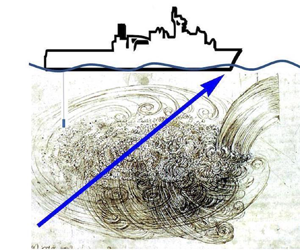Article contents
On the applicability of Taylor's hypothesis, including small sampling velocities
Published online by Cambridge University Press: 03 December 2021
Abstract

Taylor's hypothesis, or the frozen turbulence approximation, can be used to estimate also the specific energy dissipation rate  $\epsilon$ by comparing experimental results with the Kolmogorov–Obukhov expression. The hypothesis assumes that a frequency detected by an instrument moving with a constant large velocity
$\epsilon$ by comparing experimental results with the Kolmogorov–Obukhov expression. The hypothesis assumes that a frequency detected by an instrument moving with a constant large velocity  $V$ can be related to a wavenumber by
$V$ can be related to a wavenumber by  $\omega = k V$. It is, however, not obvious how large the translational velocity has to be in order to make the hypothesis valid, or at least applicable with some acceptable uncertainty. Using the space–time-varying structure function for homogeneous and isotropic conditions, this question is addressed in the present study with emphasis on small velocities
$\omega = k V$. It is, however, not obvious how large the translational velocity has to be in order to make the hypothesis valid, or at least applicable with some acceptable uncertainty. Using the space–time-varying structure function for homogeneous and isotropic conditions, this question is addressed in the present study with emphasis on small velocities  $V$. The structure function is obtained using results from numerical solutions of the Navier–Stokes equation. Particular attention is given to the
$V$. The structure function is obtained using results from numerical solutions of the Navier–Stokes equation. Particular attention is given to the  $V$ variation of the estimated specific energy dissipation,
$V$ variation of the estimated specific energy dissipation,  $\epsilon _{est}$, compared with the actual value,
$\epsilon _{est}$, compared with the actual value,  $\epsilon$, used in the numerical calculations. In contrast to previous studies, the results emphasize velocities
$\epsilon$, used in the numerical calculations. In contrast to previous studies, the results emphasize velocities  $V$ less than or comparable to the one-component root-mean-square velocity,
$V$ less than or comparable to the one-component root-mean-square velocity,  $u_{rms}$. We find that
$u_{rms}$. We find that  $\epsilon$ can be determined to an acceptable accuracy for
$\epsilon$ can be determined to an acceptable accuracy for  $V \geq 0.3\,u_{rms}$. A simple analytical model is suggested to explain the main features of the observations, both Eulerian and Lagrangian. The model assumes that the observed time variations are solely due to eddies moving past the observer, thus ignoring eddy deformation and intermittency effects. In spite of these simplifications, the analysis accounts for most of the numerical results when also eddy-size-dependent velocities are accounted for.
$V \geq 0.3\,u_{rms}$. A simple analytical model is suggested to explain the main features of the observations, both Eulerian and Lagrangian. The model assumes that the observed time variations are solely due to eddies moving past the observer, thus ignoring eddy deformation and intermittency effects. In spite of these simplifications, the analysis accounts for most of the numerical results when also eddy-size-dependent velocities are accounted for.
JFM classification
- Type
- JFM Papers
- Information
- Copyright
- © The Author(s), 2021. Published by Cambridge University Press
References
REFERENCES
- 1
- Cited by



